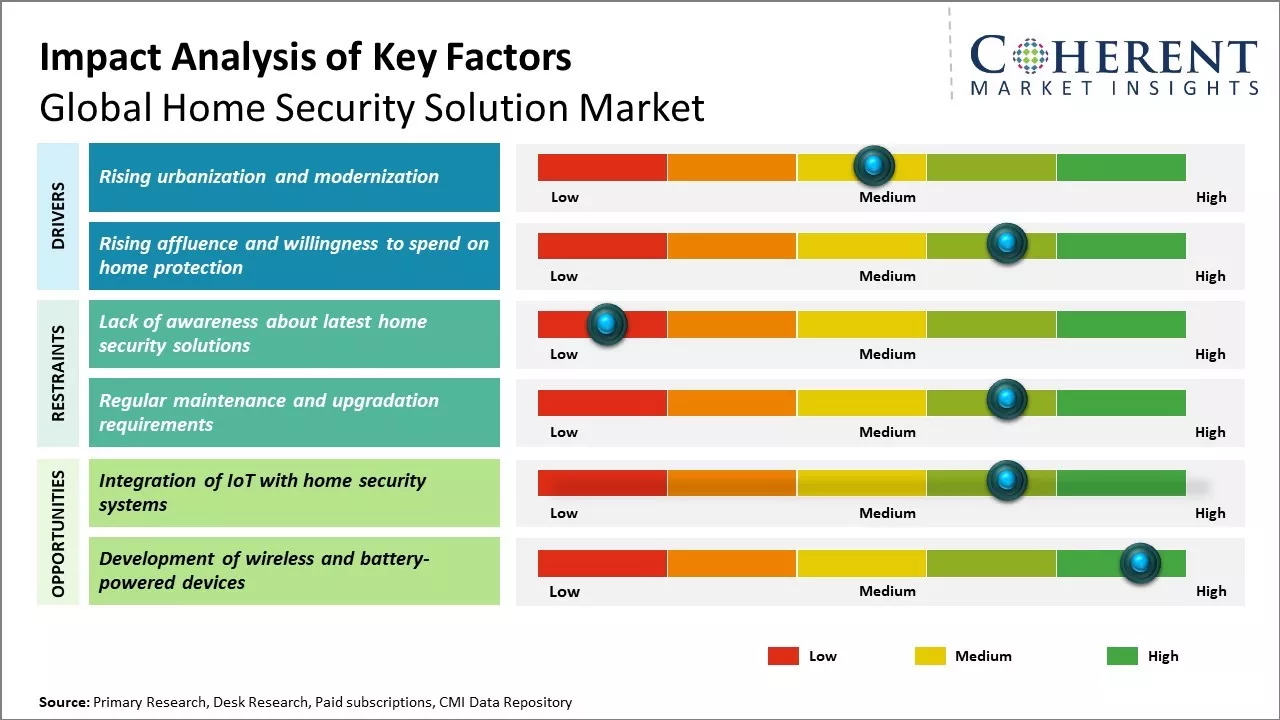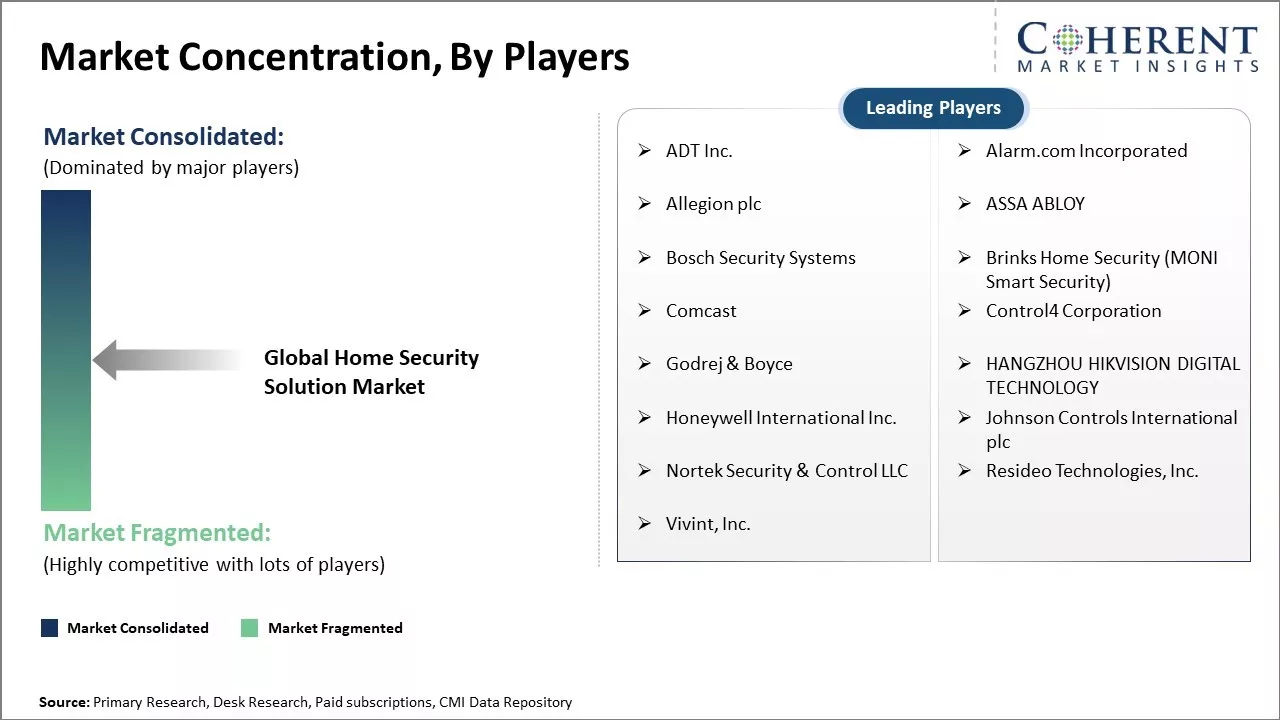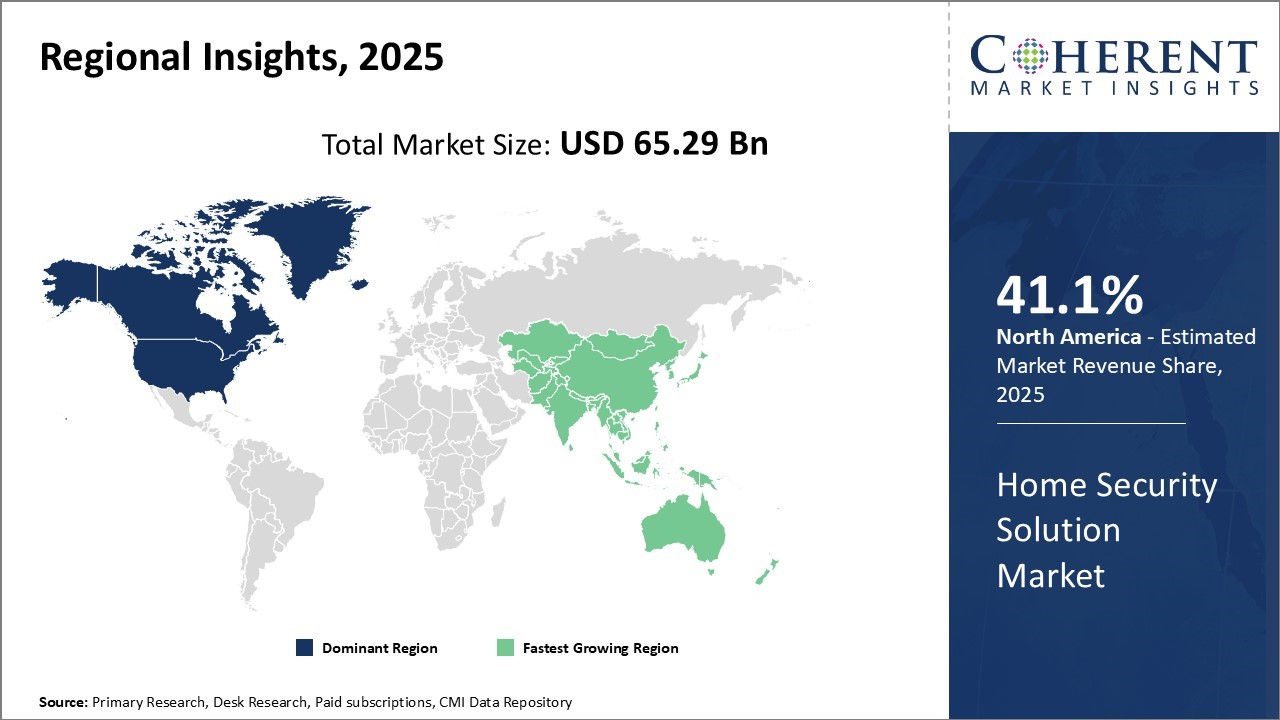Global home security solution market is estimated to be valued at USD 65.29 Bn in 2025 and is expected to reach USD 120.20 Bn by 2032, exhibiting a compound annual growth rate (CAGR) of 9.1% from 2025 to 2032.

To learn more about this report, Download Free Sample
Rising safety concerns among individuals, increasing disposable income, growing digitalization and improved living standards can boosts adoption of smart home security devices. Furthermore, market players are investing heavily in research and development to introduce innovative products with advanced technologies such as IoT and AI. The ongoing trend towards development of wireless and battery-powered home security devices can drive the market growth during the forecast period. However, high initial installation cost and technology limitations in certain regions can hamper the market growth.
|
Current Events |
Description and its impact |
|
Expansion of AI-Powered Surveillance and Threat Detection |
|
|
Smart Home Integration Fuels Bundled Security Adoption |
|
Uncover macros and micros vetted on 75+ parameters: Get instant access to report
New technology is transforming the home security solution market, driving innovation, cost savings, and smarter protection systems. The most groundbreaking disruption comes in the form of artificial intelligence (AI) and machine learning, which allows security cameras and sensors to learn to differentiate between threats and non-threats, like recognizing a family member versus an intruder or eliminating false alarms caused by pets or weather conditions.
IoT connectivity is yet another cornerstone, enabling seamless interconnectivity between devices such as smart doorbells, locks, cameras, lights, and alarms. This interconnected environment provides instant notifications, remote viewing, and control via mobile apps. 5G and Wi-Fi 6 technology are also enhancing speed and reliability, which is enhancing live streaming from security cameras to be quicker and more responsive.
Cloud storage and edge computing are also gaining traction. Cloud solutions deliver elastic video archiving and analytics, while edge computing delivers real-time device-level decision-making to reduce latency and bandwidth usage. It is particularly beneficial for AI-enabled motion detection and facial recognition.
Biometric authentication, whether through fingerprint or face scanning, is becoming more and more prevalent in smart locks and access systems to offer an added layer of personalized security. Meanwhile, blockchain technology is now also beginning to play a role in data transmission security and preventing unauthorized entry into devices.

To learn more about this report, Download Free Sample
In terms of component, hardware segment is expected to contribute the highest market share of 37.6% in 2025, due to its indispensability in forming the core infrastructure for any home security solution. Hardware equipment such as alarms, cameras, motion sensors, entry/exit sensors, and other detection devices are fundamental building blocks that enable the functionality of any security system.
Consumer demand for added layers of physical protection boosts substantial uptake of hardware products across residential installations. Video surveillance cameras have become enormously popular due to their ability to monitor premises remotely through mobile or web access. Rising smart home technologies has integrated security hardware seamlessly with other networked devices in the home.
In terms of type of system, access control system segment is expected to contribute the highest market share of 38.7% in 2025 due to the unparalleled convenience and control it provides to homeowners. Being able to securely lock/unlock doors, detect unauthorized entries, and monitor approved access from any location delivers immense peace of mind. The ability to manage who can access the property through smart locks, keypads and related equipment empowers users with tailored access rights.
This customizable access management addresses unique needs around guest privileges, delivery/service entries or child/pet safety. Through seamless integration with other systems like alarms or cameras, access control elevates the entire security experience. Its rising sophistication through technologies like biometrics, mobile credentials and automated updates is boosting popularity and drives the segment growth.
In terms of distribution channel, offline segment is expected to contribute the highest market share of 52.8% in 2025 due to consumers' entrenched preferences for hands-on research and relationships. While online shopping is increasingly adopted across many sectors, for such large investments homeowners appreciate the personal touchpoints offered through retail stores, security consultants and installation experts.
Offline avenues aid complex solution selection by providing live product demos, detailed needs analysis and post-purchase support. Established brick-and-mortar chains coupled with local security specialists have established deep expertise that engenders consumer confidence. Furthermore, a significant portion of the target audience for home security systems include older demographics who remain more comfortable with physical shopping experiences. Thus, offline channel maintains its edge despite the rising prominence of online research and purchases in other industries.

To learn more about this report, Download Free Sample
North America dominates the global home security solution market, with an estimated market share of 41.1% in 2025, due to presence of major industry players and technology innovators in the U.S. and Canada. The strong presence of leading security equipment manufacturers along with rapid adoption of smart home technologies have enabled North America to continue outpacing other regions. Growing concerns around security and safety among homeowners combined with high consumer spending power drives the market growth.
Asia Pacific has emerged as the fastest growing regional market for home security solution. Countries like China, India, Japan and South Korea boosts market expansion due to rising disposable incomes, increasing urbanization and growth of middle-class population. Improving standards of living have encouraged Asian consumers to invest more in home security devices for protection.
Furthermore, penetration of internet and proliferation of smartphones have made smart security systems more affordable and accessible in Asia. This has motivated both individual users and small businesses to incorporate advanced security measures.
Europe holds the second largest market share globally, led by developed nations such as the U.K., Germany, France and Italy. Stringent government regulations surrounding safety and security compliance of residential and commercial buildings have boosted product adoption. European companies are also actively collaborating with emerging startup firms to bring innovative solutions.
However, pricing pressures due to high tariffs and taxes on imported equipment affect the profit margins in Europe. Meanwhile, Latin America and Middle East & Africa remain highly lucrative yet untapped markets for home security solution providers to explore opportunities. Demand is steadily increasing across both regions mainly driven by growing urban populations and real estate developments.
The United States leads the world home security solution market due to extensive adoption of smart home technologies, strong consumer awareness, and presence of key players like ADT, SimpliSafe, and Ring. Growing burglary fear, presence of DIY products, and compatibility with insurance incentives continue to drive market growth.
China leads the Asia-Pacific market, boosted by rapid urbanization, smart city initiatives, and widespread adoption of AI-powered surveillance. Domestic tech champions like Hikvision and Dahua are leading cost-efficient high-tech solutions, propelling strong residential security growth within the urban environment.
Germany is a top European home security market with robust household spending, advanced infrastructure, and high standards of home safety legislation. With emphasis on energy conservation and smart home compatibility, Germany is a suitable adopter of smart security devices and IoT-enabled devices.
The U.K. shows robust growth in the uptake of home security, particularly wireless and cloud-based options. Increased crime sensitivity and insurance discount-based incentives for security system installations have driven higher penetration of technologies like smart locks, video doorbells, and motion sensors.
| Report Coverage | Details | ||
|---|---|---|---|
| Base Year: | 2024 | Market Size in 2025: | USD 65.29 Bn |
| Historical Data for: | 2020 To 2024 | Forecast Period: | 2025 To 2032 |
| Forecast Period 2025 to 2032 CAGR: | 9.1% | 2032 Value Projection: | USD 120.20 Bn |
| Geographies covered: |
|
||
| Segments covered: |
|
||
| Companies covered: |
ADT Inc., Alarm.com Incorporated, Allegionplc, ASSA ABLOY, Bosch Security Systems, Brinks Home Security (MONI Smart Security), Comcast, Control4 Corporation, Godrej & Boyce, HANGZHOU HIKVISION DIGITAL TECHNOLOGY, Honeywell International Inc., Johnson Controls International plc, Nortek Security & Control LLC, Resideo Technologies, Inc., and Vivint, Inc. |
||
| Growth Drivers: |
|
||
| Restraints & Challenges: |
|
||
Uncover macros and micros vetted on 75+ parameters: Get instant access to report
Rising urbanization as many people move to urban areas in search of better employment and livelihood opportunities can drive the market growth. People living in cities are more concerned about safety and security of their homes and properties due to rising crime rates, terrorism threats and civil unrest in many metropolitan areas.
For example, in 2024, ADT announced a partnership with tech firms to roll out AI-enabled cameras and facial recognition systems specifically targeted at urban residents concerned about theft, break-ins, and vandalism.
With rising incomes and modern lifestyles, homeowners demand advanced security measures to protect themselves and their families. The penetration of internet and proliferation of smart home devices have boosted demand for technologically advanced smart security solutions.
Homeowners are increasingly adopting sophisticated video surveillance systems, motion sensors, smart locks, home alarms and other intelligent security solutions. These solutions provide round-the-clock protection and make it possible to monitor and control the security of homes from any location via mobile apps and web interfaces.
Global home security solution market growth is driven by increasing affluence of consumers and their rising willingness to spend on protecting their homes and families. Emerging economies like India, China, Brazil and others have witnessed substantial growth in per capita incomes.
This burgeoning middle class is now able to afford best-in-class security hardware and subscription-based security services. With westernization and exposure to modern lifestyles, people across the world attach greater importance to home safety and security. These people do not hesitate to invest in sophisticated yet user-friendly security automation for seamless protection.
The ongoing work-from-home culture also boosts demand for technologically superior security monitoring from anywhere, anytime. Homeowners recognize security systems as valuable long-term investments that elevate overall living standards, lifestyle comforts and property values in the long-run. Advanced home automation integrated with security has become a necessity rather than luxury for urban populations worldwide.
The integration of IoT with home security systems provides a huge opportunity for global home security solution market growth. IoT enabled security systems allow for round-the-clock remote monitoring and control of the home from any location.
Homeowners can stay connected to their homes and receive instant notifications through their smart devices in case of intruder alarms, smoke/fire detection or unauthorized entry. This provides greater peace of mind and convenience compared to traditional stand-alone security systems.
With IoT, security systems can also be integrated with other smart home technologies like cameras, locks, lighting, thermostats and appliances. This enables automated actions and enhanced protection. For example, lights and alarms can automatically trigger if motion is detected by cameras when the residents are away. Smart locks can remotely lock/unlock based on the home occupancy.
Such tightly-integrated solutions deliver improved safety, convenience and energy savings for homeowners. Furthermore, the IoT-based home security market enables automatic alerting of emergency services in events such as fires or break-ins, while real-time footage and location data capture help accelerate response times.
Share
Share
About Author
Suraj Bhanudas Jagtap is a seasoned Senior Management Consultant with over 7 years of experience. He has served Fortune 500 companies and startups, helping clients with cross broader expansion and market entry access strategies. He has played significant role in offering strategic viewpoints and actionable insights for various client’s projects including demand analysis, and competitive analysis, identifying right channel partner among others.
Missing comfort of reading report in your local language? Find your preferred language :
Transform your Strategy with Exclusive Trending Reports :
Frequently Asked Questions
Joining thousands of companies around the world committed to making the Excellent Business Solutions.
View All Our Clients